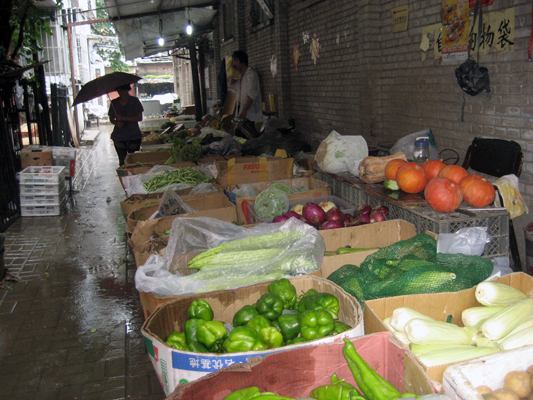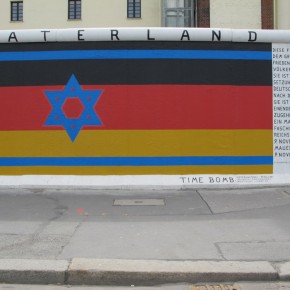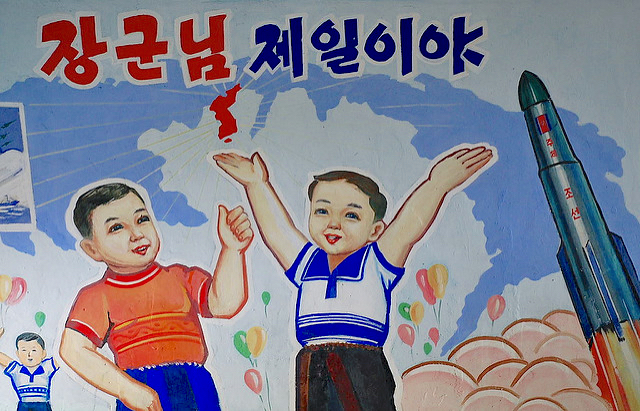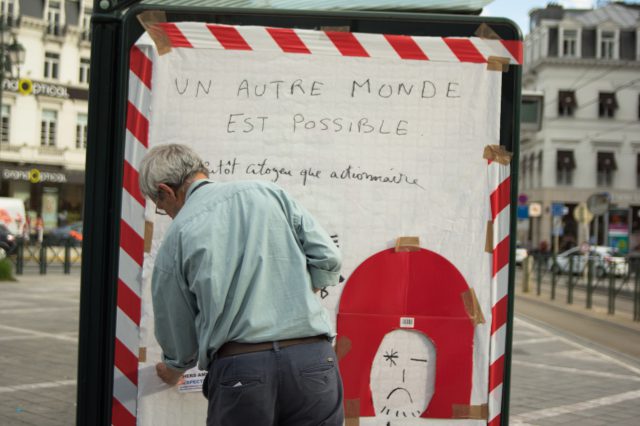About fifty meters east from the D exit of the Suzhoujie station on Beijing’s Number 10 metro line, is a small alley market. You walk along the main street, take a gated entryway for five meters, and there, parallel to the street, is a narrow alley with two stands. The first sells vegetables. The second sells peaches, apples, and lychee. A third uses crates on the sidewalk to sell brown hen and salted blue duck eggs, together with oil, pasta and a couple of common kitchen items. A fourth just beyond offers grains, rice, beans, chilis, and dry goods from sacks on the ground. That is the entire marketplace.
Altogether the alley market stretches some 25 meters, no more. Its tables are makeshift affairs, made of found materials held together by metal braces, discarded building materials, wire and twine. Cash registers are a plastic bag with loose bills and change. Traffic is reasonably brisk at the vegetable table, a little less so at the fruit table, and much less at the third and fourth sellers. At the end of the alley lies a decrepit dentist’s office and the smallest of tire stores, with about a dozen tires piled vertically and a T-shirted man sitting on a stool in front.
The vegetable table is filled with a good variety of greens. It holds asparagus, cucumbers, peppers, spinach, cabbage, mushrooms, eggplant, zucchini, white and red radishes, corn, potatoes, pumpkin, salad greens, leeks, and a couple varieties of green beans. A middle-aged man – on other visits a woman, causing me to wonder about a family relation – sells bitter melons (kÇ” guÄ), winter melon (dÅng guÄ), and pale green bottle gourds (hulu). The flowering chives (jiÅ caì huÄ) he sells add a pleasant flavor to a stir-fry.
The variety on offer in this small space exceeds that in either the Safeway or organic supermarket in my Arizona suburb, although not that of the nearby Asian supermarket or the ridiculously expensive up-scale Whole Foods. The vendors have gotten used to me and my rudimentary Chinese. Neighborhood people look curiously, beginning when I turn in from the street and pass a small cluster of elderly women sitting on steps. Caucasian faces are not usually seen in back alleys.
The Suzhou area, a couple blocks from the massive buildings of Renmin University, has seen extensive new high-rise building in recent years. Glass-and-steel office blocks, corporate headquarters, and apartment buildings intermingle, creating long visual canyons along the streets. Older brick-and-mortar apartment complexes from the 1950s and 1960s are gradually giving way to the new architectural order. An already densely-populated neighborhood is adding tens of thousands of new residents.
In the surrounding Haidian district – with some three million residents, many linked to Peking, Tsinghua and Renmin universities – is the center of Beijing’s booming knowledge-based industries. Protection for the intellectual economy of Haidian and a few similar urban zones is one reason that China’s government has adopted a passionate new concern for intellectual property law and its global enforcement apparatus.
This vegetable and fruit alley represents a different, intersecting and co-existing economy. Its economy functions alongside profoundly distinct global-oriented enterprises. Vegetable and fruit sellers will have space only so long as developers do not tear down and rebuild on this small foothold.
The alley is only slightly more permanent than mobile sidewalk businesses such as a vendor selling neatly-prepared lunches out of Styrofoam coolers in front of a workers dormitory, women hawking pink baby clothes from bags in front of a maternity hospital, open-air bicycle repair operations run by older men, and itinerant fruit-sellers parked in front of university entrances on battered Haoying trikes. These are the sort of unlicensed vendors subject to being moved on by municipal inspectors.
Alley stall-holders here do not drift like other sidewalk businesses, but share their small-capital ethos. Shop-owners on the front-side of the street are a more heavily capitalized class, investing in their shop-fronts and stock. This back-alley probably does a more lucrative business, though, providing for kitchens in the surrounding older-style apartment buildings.
Municipal authorities have permitted these sellers to construct a metal shed roof over part of this back-alley, enabling them to keep dry during the rain and string up a couple lights. An old man sits in a tiny, shabby ground-floor apartment across the narrow alley, with two open windows. He smokes and watches his television hung high on a wall. At night this old man is the gate watchman. Authorities have mounted a cheap electronic bulletin board on the gate’s brick wall. It flashes messages warning citizens to beware of pick-pockets and directs those needing help to a nearby police sub-station.
The alley space is protected, a sign of its local value. This is the last stop on the food supply chain, one that provides inexpensive nutrition to the neighborhood. By evening the stall tables are mostly empty. Their food has been, is, or will be on other tables shortly.
It is the juxtaposition of such local value against global production processes that casts into relief the concept of home. Yi-Fu Tuan has written of the centrality of ‘home’ as a geographic concept, arguing that familiarity and material support define this social idea. He defines ‘home’ as “a unit of space organized mentally and materially to satisfy a people’s real and perceived basic biosocial needs and, beyond that, their higher aesthetic-political aspirations.” This is a concept of ‘home’ that is expansible, that goes beyond an apartment door into the street and beyond. It begins with immediately proximate sites where we see, touch, and smell. In this domestic sensory environment we discover some measure of security, even enjoyment.
Writing elsewhere, Yi-Fu Tuan offers another of his geographic paradigms: “Place is security; space is freedom.” Without contradicting this formulation, the vegetable alley suggests a potential revision of this paradigm – the place of home is freedom, the space beyond home is insecurity. While they are some of the greatest travelers by force of necessity, the further poor people travel from the security of home environs, the less freedom and security in their lives. This is the opposite of the place-space relationship that those with intellectual and technical skills manifest. Mobility in space may create economic opportunity for these privileged global classes, but the place and daily practices of home attenuate and become sites of romance or nostalgia. Homelessness – in the sense of alienation from an immediate environment, not absence of a roof – represents a common condition within a regime of globalization.
The Haidian district – particularly its ZhÅngguÄncÅ«n technology center – represents for China the center of its scientific innovation and ‘new’ economy. Over 375,000 people in the district gain employment from research and development. Yet Haidian’s globalism constitutes an insecure space, one none can call home. It is the vegetable alleys and similar tenuous sites – small shops, modest restaurants, local restaurants and cafes – that create the place of home. Haidian is a mixture of pre-neoliberal Chinese society and its current surge into high technology and global markets. The homelessness inherent in sleek-surfaced towers is supplanting the ‘home’ of working-class housing projects and their side-street enterprises.
Low- or minimal-capital sites such as the vegetable alley create a fabric of recognizable social comfort, one where we can move with a sense of recognition and freedom. Enjoyment here requires little pocket money. Such sites multiply and open a familiar, accommodating local geography. In the commercial spaces of the globalist economy, ‘freedom’ is a function of available consumption capital. When Heathrow and other airports attempt to fill rental space with intimate shops, high-end vending carts, and imitation community, they engage in sober-faced parody of local small-holders and poor people crowded under street umbrellas to sell cheap goods. Richard Florida’s urban renewal concepts, influential on the international scene, provide only thin bourgeois simulacra of ‘indigenous street culture.’ These are false-front scenes whose marketing fakery gratifies – at a stiff price – a desire for home. They are places of homelessness meant for commercial transit, not residence.
While Yi-Fu Tuan offers insightful humanistic parsing of concepts of place and space, an incompleteness and absence of specificity hangs over his analyses despite their initial usefulness. Historical materialism disappears in this analytic mode, as do class and economic exploitation. Who owns space and who gets evicted from place? How does a ‘knowledge economy’ exclude so many and their knowledge? Where and in what places do the excluded shape their existence under globalization? Such questions get ignored in the ‘knowledge economy’ gold-rush.
Rapid and unapologetic transformation of local place into capital-intensive and corporate-owned spaces defines life throughout Beijing and other cities. Yet street and alley vendors do not disappear; they persist at the edges and new back alleys of the dominant economy. Home disappears only temporarily. After forced migration to poorer or less convenient neighborhoods, home gets recreated. The ‘creative class’ that Richard Florida celebrates is not the global urban bourgeoise so much as working-class people who persist, creating new homes time and again after displacement or eviction. Class segregation and neighborhood destruction do their work repeatedly and then lives get rebuilt, once more.
A community home lies in the living space between anonymous buildings or in open space re-shaped to welcome, not alienate. Home is in the interstices, in the alleys and courtyards, in the unnoticed margins. Wherever I live, these vegetable alleys are home.
Photograph by Joe Lockard





